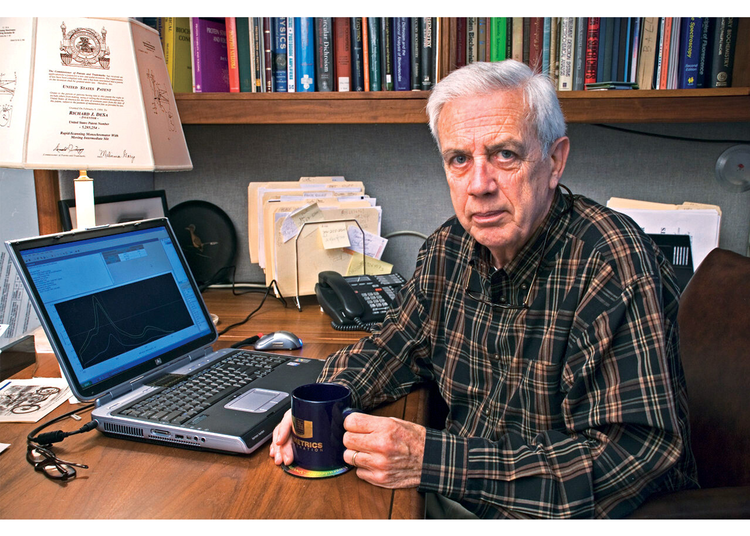The Best Guide To Spectrophotometers
Wiki Article
Unknown Facts About Circular Dichroism
Table of ContentsThe Only Guide for Circular DichroismGetting My Circularly Polarized Luminescence To WorkThe smart Trick of Circularly Polarized Luminescence That Nobody is DiscussingUv/vis Things To Know Before You Get ThisSome Known Factual Statements About Uv/vis

Spectrophotometry is a tool that hinges on the quantitative analysis of particles depending on how much light is soaked up by colored substances.
Rumored Buzz on Spectrophotometers
A spectrophotometer is typically utilized for the measurement of transmittance or reflectance of solutions, transparent or opaque solids, such as sleek glass, or gases. Although lots of biochemicals are colored, as in, they soak up visible light and therefore can be determined by colorimetric treatments, even colorless biochemicals can frequently be transformed to colored substances appropriate for chromogenic color-forming responses to yield compounds ideal for colorimetric analysis.: 65 However, they can likewise be developed to determine the diffusivity on any of the listed light ranges that usually cover around 2002500 nm using various controls and calibrations.An example of an experiment in which spectrophotometry is used is the determination of the stability constant of a service. A specific chemical reaction within a solution may happen in a forward and reverse direction, where reactants form items and products break down into reactants. Eventually, this chain reaction will reach a point of balance called an equilibrium point.
Facts About Uv/vis/nir Uncovered
The quantity of light that passes through the option is a sign of the concentration of specific chemicals that do not permit light to go through. The absorption of light is because of the interaction of light with the electronic and vibrational modes of particles. Each type of particle has a private set of energy levels associated with the makeup of its chemical bonds and nuclei and hence will soak up light of particular wavelengths, or energies, leading to distinct spectral homes.
They are extensively utilized in many industries including semiconductors, laser and optical production, printing and forensic examination, as well as in laboratories for the study of chemical substances. Spectrophotometry is frequently used in measurements of enzyme activities, decisions of protein concentrations, determinations of enzymatic kinetic constants, and measurements of ligand binding reactions.: 65 Ultimately, a spectrophotometer is additional reading able to identify, depending on the control or calibration, what substances are present in a target and exactly how much through computations of observed wavelengths.
This would come as a service to the formerly created spectrophotometers which were unable to absorb the ultraviolet correctly.
3 Easy Facts About Uv/vis/nir Explained
It would be discovered that this did not provide satisfactory results, therefore in Model B, there was a shift from a glass to a quartz prism which enabled much better absorbance results - UV/Vis (https://www.startus.cc/company/olis-clarity). From there, Model C was born with a modification to the wavelength resolution which ended up having 3 units of it producedIt was produced from 1941 to 1976 where the cost for it in 1941 was US$723 (far-UV accessories were an option at additional cost). In the words of Nobel chemistry laureate Bruce Merrifield, it was "most likely the most essential instrument ever developed towards the advancement of bioscience." Once it ended up being terminated in 1976, Hewlett-Packard developed the very first commercially readily available diode-array spectrophotometer in 1979 understood as the HP 8450A. It irradiates the sample with polychromatic light which the sample absorbs depending upon its residential or commercial properties. It is transferred back by grating the photodiode array which detects the wavelength area of the spectrum. Ever since, the production and implementation of spectrophotometry gadgets has actually increased exceptionally and has actually ended up being one of the most ingenious instruments of our time.

Circularly Polarized Luminescence - An Overview
Historically, spectrophotometers use a monochromator including a diffraction grating to produce the analytical spectrum. The grating can either be movable or fixed. If a single detector, such as a photomultiplier tube or photodiode is utilized, the grating can be scanned stepwise (scanning spectrophotometer) so that the detector can determine the light strength at each wavelength (which will correspond to each "action").In such systems, the grating is repaired and the intensity of each wavelength of light is measured by a different detector in the array. When making transmission measurements, the spectrophotometer quantitatively compares the fraction of light that passes through a reference solution and a test service, then electronically compares the intensities of the 2 signals and calculates the portion of transmission of the sample compared to the recommendation requirement.

Report this wiki page